

Granny army helps India's school children via the cloud. 30 April 2012 Last updated at 04:33 By Jane Wakefield Technology reporter Jackie Barrow explains how she teaches children thousands of miles away. The Sonic Interface Trend [Need To Know: SXSWi] Are Smart Phones Spreading Faster than Any Technology in Human History? Today’s technology scene seems overheated to some.
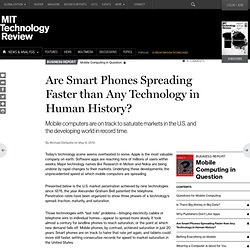
Apple is the most valuable company on earth. Software apps are reaching tens of millions of users within weeks. Major technology names like Research in Motion and Nokia are being undone by rapid changes to their markets. Underlying these developments: the unprecedented speed at which mobile computers are spreading. Cognitive software captures experts’ performance on flight simulators.
BYOD: Bring your own device could spell end for work PC. 14 February 2012Last updated at 05:00 By Fiona Graham Technology of business reporter, BBC News Out with the old: You may find yourself using your own device - laptop, tablet and/or smartphone - for work whether you like it or not.
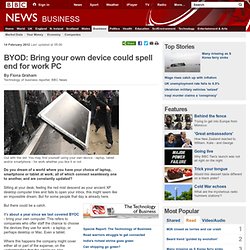
Volkswagen crowdsources its way to a Hover Car. The world of personal mobility transporters doesn't bring a whole lot of glamor.
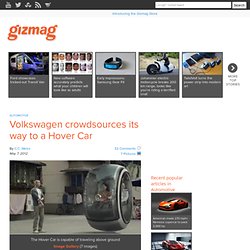
The Segway was never exactly an enviable ride, and newer concepts like the GM EN-V aren't any better. Rapidly Increased Wireless Capacity from Light Radio Cubes. Tiny Transmitters Could Help Avert Data Throttling. Major carriers, arguing that their networks are clogged with smart-phone and tablet traffic, are increasingly implementing data throttling, the practice of targeting heavy users by slowing down data-transfer speeds.

Now a gadget invented at Bell Labs—a programmable, pint-sized transmitter that requires no new traditional cell towers—could rapidly add capacity and thus help avoid data bottlenecks. The gadgets are known as light radio cubes. Measuring just six centimeters on each side, they are miniature transmitters and receivers that can be programmed to work flexibly in different contexts to add capacity.
Two devices together can serve a compact area such as a stadium or train station—handling just as much traffic, in that compact area, as a whole cell tower can serve a wider area. Apple, Amazon, Microsoft choose dirty energy to power growing cloud computing Greenpeace report evaluates 14 global IT companies’ energy choices. The report, "How Clean is Your Cloud?

," (1) shows a growing split within the tech industry between companies that are taking steps to power their cloud computing infrastructures with clean energy, like Google, Yahoo and Facebook, and companies like Apple, Amazon and Microsoft who lag behind by choosing to build their growing fleets of data centres to be powered by coal and nuclear energy. (2, 3) The report evaluates 14 major IT companies and their electricity supply chains of over 80 data centres based on key elements needed to build a clean cloud computing infrastructure. (4) "When people around the world share their photos or music on the cloud, they want to know that the cloud is powered by clean, safe energy," said Mrinmoy Chattaraj, Campaigner Greenpeace India.
"While many IT companies have made great strides in efficiency, that's only half the picture – they need to make sure their energy comes from clean sources," said Gary Cook, Greenpeace International Senior Policy Analyst. Can Crowdsourcing Resurrect Unused Patents? Big ideas: Mehmet Fidanboylu, Gabriel Mecklenburg, Daniel Perez, and Thomas von Erlach (from left) are the founding members of Marblar.
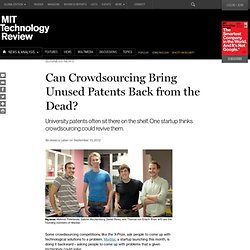
Some crowdsourcing competitions, like the X-Prize, ask people to come up with technological solutions to a problem. Marblar, a startup launching this month, is doing it backward—asking people to come up with problems that a given technology could solve. US Geological Survey detects earthquake on Twitter. High performance access to file storage Twitter has beaten instruments to the punch at the US Geological Survey – but the geeks at the country’s lead earth-sciences agency are perfectly happy.
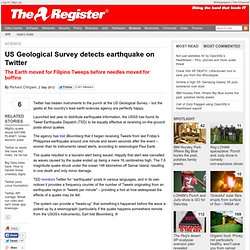
Launched last year to distribute earthquake information, the USGS has found its Tweet Earthquake Dispatch (TED) to be equally effective at receiving on-the-ground posts about quakes. The agency has told Bloomberg that it began receiving Tweets from last Friday’s Philippines earthquake around one minute and seven seconds after the event – sooner than its instruments raised alerts, according to seismologist Paul Earle. The quake resulted in a tsunami alert being issued. Happily that alert was cancelled as waves caused by the quake ended up being a mere 16 centimetres high. Rooting out rumors, epidemics, and crime. A team of EPFL scientists has developed an algorithm that can identify the source of an epidemic or information circulating within a network, a method that could also be used to help with criminal investigations.

Investigators are well aware of how difficult it is to trace an unlawful act to its source. The job was arguably easier with old, Mafia-style criminal organizations, as their hierarchical structures more or less resembled predictable family trees. Identifying the brains behind a terrorist attack or an infectious-disease primary source. The network of hijackers involved in the September 11, 2011 attack and their associates.
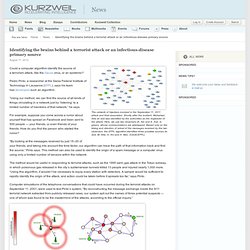
Shortly after the incident, Mohamed Atta (in red) was identified by the authorities as the ringleader of the attack. Here, we use two observers (A.